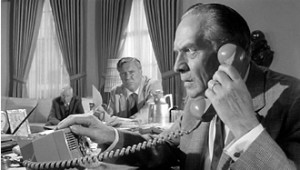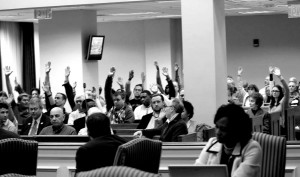Speaking recently at a British conference on urbanism, Daniel Libeskind called for a greater degree of public participation in the design process. “The people have to be empowered to be involved in shaping the program, not just the program but also the actual space,” he said. Let the voice of the people be heard! I was reminded of this tired nostrum as I was watching Seven Days in May. In a taped commentary, director John Frankenheimer several times emphasized that this excellent movie, shot in 1963, could not be made today (he died in 2004). Imagine, a political thriller without a shooting, a fight, or even a car chase! One of the differences in 1963 was the absence of preview screenings. Frankenheimer speculated that had the film been subjected to a test viewing, as almost all movies are today, someone would have complained about the long scenes and extended dialogue, or the complicate plot and the lack of action, and changes would have been ordered.

The architectural equivalents of the pre-release preview are the community boards, design review panels, and neighborhood oversight committees that “screen” new projects before they are built. It is virtually impossible to realize an urban building today without considerable input from the public. Sounds democratic, but the problem is that the The Public is often those who shout loudest and complain the most, well-meaning pressure groups, single-issue lobbies, and disgruntled individuals. It is hard to believe that more of this process, which tends to produce improvised compromises and mealy-mouthed consensus, would really raise the quality of the built environment.


Despite the crowd pleasing sound bite, Daniel Libeskind is the person least interested in public process or indeed in accomodating the ideas or the opinions of others. He has used backroom politics, called in favors and played the Holocaust victim ‘race card’ among a host of other seedy tactics to foist his miserable architecture on cities and buildings better than anything he can personally imagine. If his recent excresences in Las Vegas, Denver, Toronto or in Dresden were the result of “public participation”, I shudder to think what Libeskind’s original and unrestrained vision must have been like.
It’s bad enough that Daniel Libeskind is allowed to participate in the design process, but let’s not allow more amateurs to influence a process that they don’t fully understand. There’s a point at which too much democracy is just plain bad. Architecture is only one of the things that suffers.
Interesting but disagree. The public urban environment and design decision-making in city after city, including New York and Los Angeles, is far superior today than it was thirty years ago and the outcomes are far better as well. Public discourse and participation may lop off the occasional design innovation (name three that were truly eliminated by public discourse) but in general, even with the shouting and the compromise, crowd sourcing city design has raised the bar.
I was thinking of my own neighborhood, Chestnut Hill. Several years ago a local restaurant applied for a building permit. Since a liquor licence was involved, he was subjected to public hearings. Of course immediate neighbors showed up to complained about traffic, parking, smells. Finally, discouraged, the restauranteur withdrew (and built downtown instead). We now have a Macdonalds on that site.
I can certainly relate to the MacDonalds anecdote but I refuse to always point fingers at a vocal public minority while many designers remain publicly silent about their own neighborhoods and cities. We need to be better at supporting development we believe in and affecting change in those we don’t (I know this can be problematic for Architects are susceptible to slander and libel lawsuits). It must also be said that the nature of public input is shifting dramatically with the popularity of social media forums and greater access to information about our buildings and cities. Great design ideas are also being generated from public arenas – The Highline exists because of two local (and vocal) non-designer citizens and sites like Kick-starter are providing a democratized funding process. I think we need to embrace these new tools, be proactive leaders about projects in our communities and make our voices a much louder.
You may be right about the value of social media. It may be a medium that encourages broader and more thoughtful participation, compared to the often charged atmosphere of public meetings.